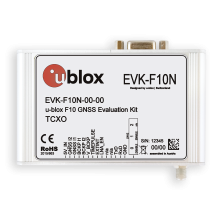
EVK-F10N
u-blox F10N GNSS evaluation kit
Insights
|
18 Sep 2023
Dual-band GPS optimizes positioning accuracy in urban environments, while dead reckoning technology packs even more benefits

It’s somewhat ironic that GPS-based solutions struggle most where they are most used: in urban environments. At best, deep urban canyons, underpasses, tunnels, built canopies, and indoor parking briefly deteriorate global navigation satellite system (GNSS) signal quality and position accuracy. At worst, they interrupt service altogether, potentially handicapping businesses that depend on accurate positioning to track their vehicle fleets, streamline operations and maintenance, and manage billing.
There are a variety of solutions that help reduce outliers to deliver more stable performance – under the right circumstances. GNSS receivers that track multiple satellite constellations, for example, increase the number of satellites within line of sight at any given time, even when only a small portion of the sky is unobstructed. While this reduces the likelihood of having too few signals to calculate a position estimate, multipath effects, caused when GNSS signals bounce off facades before reaching the receiver, persist as a concern.
Dual-band GNSS technology aids in mitigating these multipath effects by tracking signals in frequency bands that take different paths to reach the receiver. Multi-band positioning solutions, such as L1/L5 GPS receivers, have been developing considerably and will improve positioning performance in urban environments. Still, it will take some time to access reliable data from customers and end users to assess the overall benefits. In the meantime, it’s worth pointing out how dead reckoning aids in solving many of the urban positioning challenges mentioned above.
Dead reckoning solutions uniquely overcome some of these challenges, delivering improved position accuracy in typical urban environments by drawing on inertial sensors embedded in the GNSS receiver module as well as, when available, additional data from the vehicle’s wheel tick sensor.
They do so by combining inertial sensor data and a dynamic model accounting for all possible movements of the vehicle to eliminate poor position estimates caused by multipath effects or poor signal environments.
But dead reckoning goes a few steps further. Here are three ways dead reckoning adds value to vehicle fleet management solutions.
Weak GNSS signals fail to penetrate through even thin, opaque structures. As a result, indoor parking garages, tunnels, and even underpasses typically cause a complete interruption of GNSS service.
Even when GNSS signals are absent, IMU-based positioning continues, offering a complementary source of position information that can bridge gaps in satellite signal availability.
In addition to enhancing coverage of the positioning service, the inertial sensors that dead reckoning solutions draw on offer increased resilience against two of the most common methods of tampering with GNSS receivers – jamming and spoofing.
Hackers can, for instance, disrupt their operation by jamming them with loud radio-frequency noise.
Alternatively, they can trick receivers into reporting false positions by spoofing them with fake GNSS signals. In these cases, inertial sensors offer a valuable complementary data source to maintain position service when signals are jammed or detect discrepancies between the GNSS and IMU output when signals are spoofed.
GNSS receivers, even L1/L5 GPS receivers, often work with sub-optimal satellite signal quality, whether due to RF interference caused by nearby cellular modems or physical obstructions such as trees and buildings. In these cases, inertial sensor-based positioning can reduce the GNSS receiver’s position estimate to ensure that temporarily poor signal quality does not translate directly into inaccurately reported positions.
Dead reckoning solutions can also provide valuable inertial sensor raw data that fleet managers and vehicle insurers can tap into to gain previously hard-to-access information.
This ranges from using the wake-on-motion functionality for theft detection or detecting minor collisions on parked vehicles to helping insurance companies reduce expenses associated with unjustified claims.
Additionally, it can be used to assess driver behavior, potentially resulting in reduced insurance rates for companies with cautious drivers and increased rates for those with reckless driving habits.
Dual-band and dead reckoning solutions evolve at a fast rate. On one hand, dual-band positioning solutions are easy to implement, as they only require a dual-band GNSS receiver and antenna. Moreover, the latest generation of dual-band receivers, such as L1/L5 GPS receivers, should significantly improve positioning performance in urban areas under heavy multipath conditions compared to previous receivers.
On the other hand, dead reckoning technology improves accuracy in urban areas, extends positioning service beyond the reach of GNSS signals, increases resilience against jamming and spoofing, and offers new functionalities for fleet management and vehicle insurance companies.
Ultimately, we will witness a shift toward sophisticated solutions and mass-market applications that enhance positioning performance and extend it to an ever-growing set of environments. In the long run, merging multiband GNSS and dead reckoning will undoubtedly improve the reliability of GNSS positioning in our cities.
In the meantime, learn more about u-blox’s solutions. The u-blox NEO-F10N, a dual-band GNSS positioning module, offers meter-level accuracy and multipath mitigation for urban environments. To evaluate all u-blox F10 GNSS features, you can rely on the EVK-F10N kit.
The u-blox NEO-M9V receiver, a single-band GNSS module that provides untethered and automotive dead reckoning (UDR and ADR), has been specifically designed for fleet management and micromobility applications. Test the module’s functionality and push it to its limits with the EVK-M9DR evaluation kit.
Contact your sales representative for questions, technical support, and further information. We look forward to hearing from you.
Mathias Vetter
Principal Product Manager, Consumer and Industrial Tracking